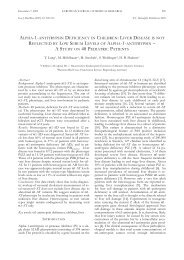European Journal of Medical Research - Deutsche AIDS ...
European Journal of Medical Research - Deutsche AIDS ...
European Journal of Medical Research - Deutsche AIDS ...
You also want an ePaper? Increase the reach of your titles
YUMPU automatically turns print PDFs into web optimized ePapers that Google loves.
June 27, 2007 EUROPEAN JOURNAL OF MEDICAL RESEARCH<br />
1<br />
Abstracts eingeladener Referenten<br />
A. Gesellschaftliche Aspekte von HIV<br />
und <strong>AIDS</strong><br />
A.ER.1<br />
Recency estimations <strong>of</strong> HIV infections and<br />
implications for risk analyses: Results from a pilot<br />
study in Berlin 2005 - 2007<br />
Bätzing-Feigenbaum J. 1 , Kücherer C. 2 , Loschen S. 2 ,<br />
Gohlke-Micknis S. 1 , Poggensee G. 1 , Jansen A. 1 ,<br />
Hamouda O. 1<br />
1 Robert Koch Institute, Department <strong>of</strong> Infectious Disease<br />
Epidemiology, Berlin, Germany, 2 Robert Koch Institute, HIV<br />
Variability and Molecular Epidemiology, Berlin, Germany<br />
Objective: The number <strong>of</strong> newly diagnosed HIV infections in<br />
Germany re-increased from 1.444 in 2001 to 2.486 in 2005.<br />
However, the true incidence <strong>of</strong> new HIV infections may not<br />
be reflected in these numbers, since the time span between infection<br />
and diagnosis is highly variable and is influenced by<br />
many factors. Incident infections will be discovered only partly<br />
by routine clinical care.<br />
Methods: Blood samples were collected from adult patients<br />
(18 years) with HIV infections newly diagnosed by practitioners<br />
and clinics in Berlin between 2005 and early 2007,<br />
and tested at RKI using BED-CEIA. This method allows estimating<br />
recency <strong>of</strong> HIV infections. For BED-CEIA negative<br />
samples it can be estimated that infections were acquired not<br />
longer than 140 days ago. Clinical data were contributed by<br />
the physician and data on knowledge, attitudes and behaviour<br />
in terms <strong>of</strong> HIV/<strong>AIDS</strong> through a patient questionnaire. Date<br />
collection was anonymous and unlinked.<br />
Results: By end <strong>of</strong> January 2007 116 individuals were enrolled.<br />
102 were MSM (88%). The proportion <strong>of</strong> recent infections<br />
in MSM is 47% (CI [95%]: 38; 56) and 14% (CI [95%]:<br />
32; 0) in individuals from other groups at risk. In the MSM<br />
group the proportion <strong>of</strong> recent infections is higher in the<br />
younger age group 20 – 29 years than in the 30 – 44 year<br />
range (64 versus 48%). 33% <strong>of</strong> MSM recently infected with<br />
HIV stated to live in non-monogamous partnerships in the<br />
past 6 months. 79% had unprotected sex, 64% unprotected<br />
anal intercourse. 30% <strong>of</strong> them had not used condoms consistently<br />
in the past 6 months because they didn’t feel at risk<br />
and/or believed their sexual partner were not infected with<br />
HIV.<br />
Conclusions: Estimating recency <strong>of</strong> HIV infections allows<br />
more relevant analysis <strong>of</strong> behavioural risk factors for acquiring<br />
HIV. This is important since attitudes and behaviour towards<br />
HIV change over time. Despite a small number <strong>of</strong> participants<br />
in this pilot study, the results suggest delayed diagnosis<br />
in women and other population groups compared with<br />
MSM. MSM with recent HIV infections report high risk behaviour<br />
with regards to condom use. The findings have implications<br />
for prevention strategies and underline the potential<br />
usefulness <strong>of</strong> extending second generation HIV surveillance<br />
in Germany.<br />
A.ER.2<br />
Intensivierte epidemiologische Surveillance von<br />
HIV-Erstdiagnosen in der Schweiz<br />
Gebhardt M. 1 , Daneel S. 2 , Vernazza P. 2 , Schüpbach J. 3 ,<br />
Werner M. 1 , Staub R. 1 , Boubaker K. 1<br />
1 Bundesamt für Gesundheit, Übertragbare Krankheiten, Bern,<br />
Switzerland, 2 Kantonsspital St.Gallen, Infektiologie und<br />
Spitalhygiene, St. Gallen, Switzerland, 3 Nationales Zentrum<br />
für Retroviren, Zürich, Switzerland<br />
Ziele: Evidenzbasierte Verbesserung der HIV-Surveillance in<br />
der Schweiz.<br />
Methodik: Neue HIV-Diagnosen werden von den Labors<br />
gemeldet. Ärzte melden ergänzende Informationen mittels<br />
eines Formulars (EM). Während eines Jahres (1.7.2005-<br />
30.6.2006) wurde mit jeder neuen HIV-Diagnose wie folgt<br />
verfahren:<br />
- ein kurzer zusätzlicher Fragebogen für den Arzt (AFB)<br />
- ein ausführlicher Fragebogen für den Patienten (PFB)<br />
- Durchführung eines Interviews mit dazu einwilligenden Patienten<br />
- BED-Aviditäts-Assay zur Identifizierung von frischen Infektionen<br />
("FI",





